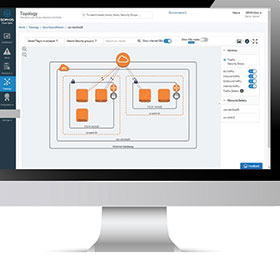

While the public cloud solves many traditional IT resourcing challenges, it does introduce new challenges. The rapid growth of cloud usage has resulted in a fractured distribution of data, with workloads spread across disparate instances and, for some organisations, platforms. As a result, keeping track of the data, workloads, and architecture changes in those environments to keep everything secure is often a logistical nightmare.
While public cloud providers are responsible for the security of the cloud (the physical data centres, and the separation of customer environments and data), once businesses put data and workloads in the public cloud they become personally responsible for securing them.
“The secret to effective public cloud security is improving your overall security posture. You need to ensure your architecture is secure and configured correctly, and that you have visibility into both your architecture and who is accessing it. In addition, irrespective of where your infrastructure and data is held, you need to demonstrate compliance with relevant regulations, including CIS, HIPPA, GDPR, and PCI or you will risk regulatory non-compliance,” says Andre Kannemeyer, CTO at Duxbury Networking.
The challenge in the cloud is that environments change constantly. Kannemeyer points out that whereas compliance checks every week or month may have worked for on-premise networks, they are not adequate for the public cloud. The need for continuous compliance analysis can be a huge resource drain for teams that are managing cloud environments manually or with native tools. In addition, once a compliance issue is identified, the fractured nature of security, development, operations and compliance teams within most organisations means it is often challenging to address the situation in a timely manner.
“There are many elements to public cloud security and it can be difficult to know where to start. If you’re using the public cloud – or thinking about migrating – we recommend seven steps to help maximise your security,” he says.
Step 1: Learn your responsibilities
Security is handled a little differently in the cloud. Public cloud providers such as Amazon Web Services, Microsoft Azure, and Google Cloud Platform run a shared responsibility model – meaning they ensure the security of the cloud, while you are responsible for anything you place there.
Step 2: Plan for multi-cloud
Multi-cloud is no longer a nice-to-have strategy. Rather, it has become a must-have strategy. There are many reasons why you may want to use multiple clouds, such as availability, improved agility, or functionality. When planning your security strategy, start with the assumption that you will run multi-cloud – if not now, at some point in the future. In this way you can future-proof your approach.
Step 3: See everything
If you cannot see it, you cannot secure it. That is why one of the biggest requirements to getting your security posture right is getting accurate visibility of all your cloud-based infrastructure, configuration settings, API calls and user access.
Step 4: Integrate compliance into daily processes
The dynamic nature of the public cloud means that continuous monitoring is the only way to ensure compliance with many regulations. The best way to achieve this is to integrate compliance into daily activities, with real-time snapshots of your network topology and real-time alerts to any changes.
Cyber criminals increasingly take advantage of automation in their attacks. Stay ahead of the hackers by automating your defences, including remediation of vulnerabilities and anomaly reporting.
Step 6: Secure all your environments
You need a solution that can secure all your environments (production, development, and QA) both reactively and proactively.
Step 7: Apply your on-premise security learnings
On-premise security is the result of decades of experience and research. Use firewalls and server protection to secure your cloud assets against infection and data loss, and keep your endpoint and email security up to date on your devices to prevent unauthorised access to cloud accounts.
Combine the power of AI and automation
“Moving from traditional to cloud-based workloads offers huge opportunities for organisations of all sizes. Yet securing the public cloud is imperative if you are to protect your infrastructure and organisation from cyberattacks,” says Kannemeyer.
Sophos Cloud Optix agentless, SaaS-based service combines deep security expertise with the power of artificial intelligence. It delivers cloud security monitoring, analytics, and compliance automation with one simple-to-use interface in a process-efficient way.
It allows automatic discovery of an organisation’s assets across Amazon Web Services (AWS), Microsoft Azure, and Google Cloud Platform environments, giving companies the power to respond to and remediate security risks in minutes.
As workloads move to the cloud, Cloud Optix reduces the cost and complexity of governance, risk, and compliance. Out-of-the-box templates, custom policies, and collaboration tools help businesses to continuously monitor compliance with custom or out-of-the box templates for standards such as CIS, GDPR, SOC2, HIPAA, ISO 27001, and PCI DSS.
Cloud Optix continuously monitors and learns about one’s cloud asset inventory, configurations, and network traffic. AI-powered smart alerts reduce response times and help remediate security risks faster with automated alert ranking combined with contextual information.
| Tel: | +27 11 351 9800 |
| Email: | info@duxnet.co.za |
| www: | www.duxbury.co.za |
| Articles: | More information and articles about Duxbury Networking |

© Technews Publishing (Pty) Ltd. | All Rights Reserved.